15 Gretsch electric guitar stars

Eddie Cochran
You know the score by now. Here at MusicRadar, we love celebrating those perfect combinations of artist and instrument that burn brightest in the history of popular music. So far we've loved Les Paul legends, stroked the egos of Strat stars, run riot on Rickenbacker pickers and many more. Now, it's time to look at some of the guitarists - both contemporary and from decades past - who have made the Gretsch sound their own. And who better to kick off the list than a genuine trailblazer...
There are Gretsch players, and there are Gretsch players. And there are rock 'n' roll stars. And then there's Eddie Cochran. Killed in a car crash at just 21 years of age, Cochran's career was cut tragically short, but his influence cannot be overstated and still resonates at the pounding heart of rock 'n' roll.
Paul McCartney passed the most important audition of all time when John Lennon - then of The Quarrymen - heard him play Cochran's Twenty Flight Rock. Widely credited as the first guitarist to use an unwound third string for easier bends, artists as diverse as The Who, Hendrix, Bolan, The Sex Pistols, Brian Setzer and Rory Gallagher counted Cochran as a key influence. And if there's a better distillation of the spirit of rock 'n' roll than the car and girl-fixated Somethin' Else... well, frankly, there isn't.
At NAMM 2010, Gretsch announced a rather special Eddie Cochran tribute guitar. Read all about it here.
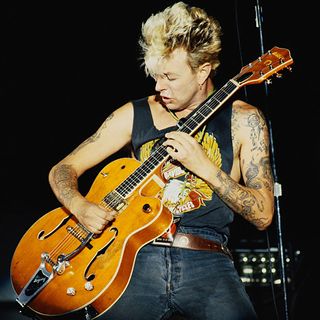
Brian Setzer
You’re a rockabilly-crazed trio from Long Island in the late ’70s. Moustaches and Foreigner rule. What to do? Move to jolly ol’ England, of course!
Setzer and his other two Stray Cats (bassist Lee Rocker and drummer Slim Jim Phantom) went down a smash in the UK, riding a rockabilly revival that soon became a revolution. Two years later, aided by MTV, they brought their success back to the States, and with stripped-down, no-keyboards-allowed hits like Rock This Town, Runaway Boys and Stray Cat Strut, they became stars.
Key to Setzer’s sound - an exuberant blend of boogie-woogie and blues with an almost jazz sensibility - is a 1959 Gretsch 6120 that the Eddie Cochran-obsessed guitarist bought from the classifieds for the way-beyond-retro price of $100.
Whether it’s with The Stray Cats (who broke up in 1984 but have reunited several times), on side projects like Robert Plant’s The Honeydrippers or with his current big band, The Brian Setzer Orchestra, you won’t find him playing anything other than Gretsch. (And forget that three-position ’mud switch’ - don’t need it.)
Gretsch has issued numerous Brian Setzer models over the years.There was even a limited-edition Brian Setzer Tribute guitar - appropriately, only 59 were made.
Want to know how to play like him? Who better than the man himself to talk you through rockabilly picking using barre chords, using a Bigsby vibrato, rockabilly picking using open chords and how to change between picking and fingerstyle.
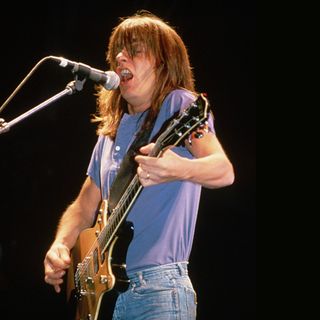
Malcolm Young
It’s hard to compete with a younger brother who prances around in a schoolboy’s uniform and plays all the leads, so Malcolm Young doesn’t even try. No matter: his immediately recognisable, hooky, three-chord style provides AC/DC with their power and has led millions down the Highway To Hell.
During the Bon Scott-era, Malcolm played and customised a 1963 Gretsch Jet Firebird guitar handed down to him by elder brother George Young, who was in The Australian band The Easybeats. Malcolm's mods included stripping the red paint, removing the neck and middle pickups and stuffing socks in the cavities to reduce feedback.
Back In Black (the Brian Johnson era) saw Malcolm add White Falcons to the mix. His first, a ‘59, was sold on after he claimed that it had ‘lost its sound’ following a repair.
Other than that, give Malcolm heavy strings (.012-.056) and plug him into Marshall amps (Super Leads and Super Basses) and away he goes. Gretsch currently produces two Malcolm Young signature Jet reissues, in both single and double FilterTron pickup configurations.
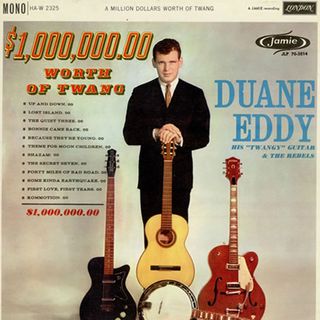
Duane Eddy
How’s this for popular? In just one year, 1958, Duane Eddy not only released the staggeringly influential instrumental hits Movin’ N’ Groovin’, Ramrod, Rebel Rouser and Cannonball, but the following year NME voted him - get this - “World’s Number One Music Personality.” Guess they forgot about a certain hip-shaker who went into the army.
The twangy guitar of Duane Eddy (he even had an album called Have Twangy Guitar, Will Travel) set the world on fire, particularly in the UK where The Shadows were major devotees. And check out George Harrison’s growling notes in the verses of I Want To Hold Your Hand - that could easily have been Duane Eddy.
The ‘60s and ‘70s saw Eddy’s career lose steam, but in 1986 The Art Of Noise scored a smash with a remake of Duane’s 1959 hit, Peter Gunn - and, of course, they knew who to call to add the guitar.
Even though Eddy was the first rock ‘n’ roll guitarist to have his own signature model (a Guild DE-400 in 1960), he made most of his important recordings with a 1957 Gretsch 6120.
In 1997, however, Gretsch bestowed upon Eddy his own artist series, the 6120-DE, similar to the ‘57 that had served him so well, complete with DynaSonic pickups that approximated the bright, airy quality of the original single-coil DeArmonds.
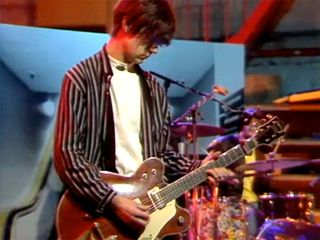
John Squire
Before the destructive excess and blues rock jams of The Second Coming, The Stone Roses were a psychedelic pop band with an untouchable rhythm section and, in John Squire, a genuine contender to rival to Johnny Marr for the accolade of the best English guitarist of the generation.
The swirling Byrdsian jangle and hypnotic chime of The Stone Roses' sublime debut album was the aural equivalent of Squire’s Jackson Pollock-influenced cover art: a blissed-out, narcotic rush that found the band spiritually aligned with the late 1980s rave scene as much as sun-drenched 1960s pop.
Hear Squire’s ’64 Country Gentleman put to good use on Waterfall, live at Blackpool Empress Ballroom in 1989.
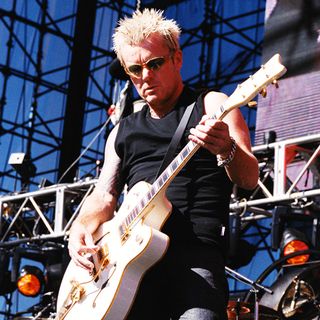
Billy Duffy
Inspired by Bow Wow Wow’s Matthew Ashman, Billy Duffy bought his first Gretsch White Falcon while a member of the band Theatre Of Hate. It wasn't the exact model he wanted; he had to settle for a Baldwin-era double-cutaway.
After meeting singer Ian Astbury and forming Southern Death Cult (soon shortened to simply The Cult), Duffy got his hands on the guitar of his dreams: a mid-‘70s, single-cutaway Falcon.
This is the guitar he used on the highly influential 1985 album Love, which featured the band‘s signature song, She Sells Sanctuary. To achieve his distinctive sound, a bewitching blend of chiming, echo-laden riffs and three-chord crunch, Duffy stuffed his Falcon, equipped with Seymour Duncan PowerTron pickups, with T-shirts, makeup pads, cotton balls - whatever was handy - to minimize unwanted feedback.
During the late ’80s, Duffy would make considerable use of Les Pauls on more harder-edged records, but he always came back to his White Falcons.
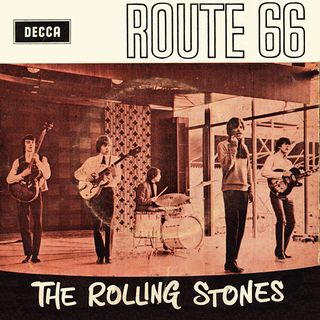
Brian Jones
The Rolling Stones' bête noire had one of the coolest guitar collections of the era, but before the Vox Teardrops and Gibson Firebirds, Jones used a 1963 Gretsch 6118 Double Anniversary live and in the studio from late 1963 to mid '64.
In this brief but iconic period, the guitar featured on the classic Stones recordings of I Wanna Be Your Man - that slide part on the first beat of the bar - and It's All Over Now, and early UK television performances including Thank Your Lucky Stars.
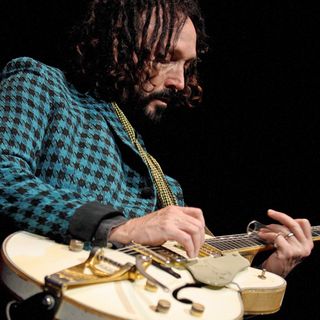
Mike Campbell
Although the core of the Tom Petty sound - that Byrds-like ring on hits like American Girl and The Hardest Part - owes much to Rickenbackers, Petty’s right-hand man, Mike Campbell, doesn’t stick to one guitar.
Take that Ennio Morricone-meets-surf solo in You Got Lucky - Campbell used a double-cutaway 6120 Nashville Gretsch to nail that sucker. And his tasteful slide solo on I Won’t Back Down was played on a single-cutaway Country Gentleman.
Campbell is an avid collector who owns dozens of makes and models (he even has a Duesenberg signature guitar), but he has a soft spot for Gretsches and has been known to pull out a couple - a 1956 Fire Jet and a late ‘50s White Falcon, say - during concerts. But you won’t see his early ’60s Tennessean on stage - Campbell leaves that baby at home.
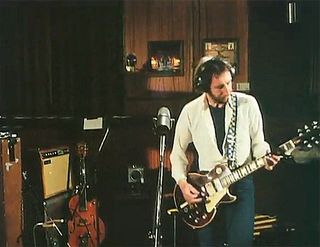
Pete Townshend
In the early days of The Who, Pete Townshend demolished his fair share of Rickenbackers and Gibson SGs. In 1973, however, he took out his rage on a Gretsch that was gifted to him by Joe Walsh.
This particular guitar, a 1959 6120 Chet Atkins Hollow Body (featuring two FilterTron pickups and a nickel-plated V-shaped Bigsby), almost met its untimely end on the Top Of The Pops TV show in October 1973. Incensed (or was it simply showmanship?) that the band couldn’t perform the song 5:15 in its entirety, Townshend first kicked over Keith Moon’s drums (Moon, of course, joined in) before giving his Gretsch what-for. Check out the knockout clip here.
Townshend used the hollow-body on many of his post-Tommy Who recordings - Who’s Next and Quadrophenia are two stunning examples - and, after the instrument was repaired (only the neck was broken), he continued to employ it on both band and solo albums.
Last we heard, the guitar was still in one piece.
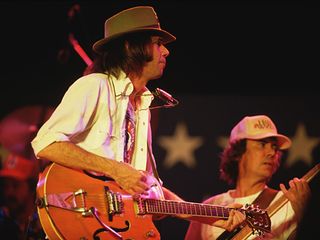
Neil Young
Although the 1953 Old Black Les Paul is perhaps his best-known axe, Neil Young has played Gretsches since his days in Buffalo Springfield, starting with a 1959 6120 Chet Atkins Hollow Body.
Later, in Crosby, Stills, Nash & Young, he traded Steven Stills a Gretsch mono 6136 Falcon for a 1959 stereo single-cut White Falcon. Indeed, much of the sound of the Déjà Vu album - to say nothing of the 1970 song Ohio - is informed by the sound of those two Gretsches.
Young would eventually modify the White Falcon with a B7 Bigsby. Around 1974, he would add a double-cutaway model to his collection.
Old Black might receive all of the ragged glory, but Young continues to rely on his Gretsches. Here he is playing his 6120 at the first Farm Aid in 1985. As late as last year, he was seen putting that same guitar through its paces on stage. Hey hey, my my!
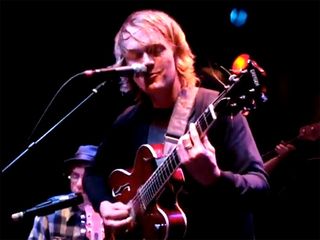
Adam Stephens
Comparatively unknown in this company, Adam Stephens made his name as singer-songwriter in folk/blues duo Two Gallants; his weatherworn howl underpinned by wonderful fingerpicked guitar with a timeless, haunted quality remarkable for a man in his twenties.
An expert at filling out the bass while executing elegant arpeggiated parts and screaming his lungs out at the same time, Stephens’ reverb-drenched Gretsch hollow-body is caressed and attacked in equal measure, his influences older than rock ‘n’ roll, mining pre-war Americana and the folk tradition.
The uninitiated should begin with the sublime Despite What You’ve Been Told and work backwards through Two Gallants’ astounding discography. In addition, watch out for solo material from Stephens featuring a full backing band in 2010.
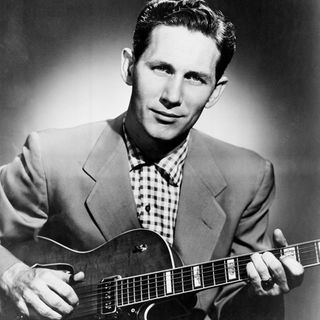
Chet Atkins
With the possible exception of Les Paul, no single guitarist has had such a profound impact on instrument design as Chet Atkins. Already a major star in country music, his technique of plucking chords and melody lines with his fingers while using his thumb for bass was highly influential.
Atkins, who had earned the nickname “Mr Guitar,” began his association with Gretsch in 1954. The first guitar to bear the Chet Atkins name, the 6120, was a hollow-body arch top initially adorned with Western styling, debuted that same year and is regarded as the definitive Gretsch guitar.
Gretsch and Atkins continued to develop instruments, such as the hugely popular 1957 Country Gentleman, an elegant, single-cutaway, semi-hollow model that featured FilterTron pickups (Atkins wasn‘t a fan of DeArmonds, which were featured on many of the company‘s earlier guitars).
Sales of the Country Gentleman would soar in 1964 when George Harrison appeared on the Ed Sullivan Show playing a slimed-down, double-cutaway version. Other Atkins-branded Gretsches would follow, one of the biggest being the single-cutaway 6119 Tennessean, a lower-priced version of the Country Gentleman that featured real f-holes - Atkins was constantly hounding Gretsch to stop painting them on. George Harrison helped popularise the Tenny, as well.
Atkins’s discography is massive. In addition to over 50 solo albums to his credit, he recorded with artists such as Hank Snow, The Boston Pops Orchestra, Mark Knopfler, Les Paul, Jerry Reed and many others. Atkins died in 2001 at the age of 77.

Bo Diddley
Few guitarists are so cemented in the history of popular music that their name has become synonymous with a beat. But Bo Diddley was much more than just a guitarist.
An outrageous performer, Diddley was a Gretsch man with a penchant for some really out-there guitars, most notably the Twang Machine, his rectangular six-string fashioned in 1958.
In 2005, Gretsch announced the automobile-inspired 'Billy Bo' Jupiter Thunderbird, based on the guitar designed by Bo Diddley in 1959 which was later given to ZZ Top frontman Billy Gibbons. These days, you can even find fellow Gretsch lover Jack White rocking one.
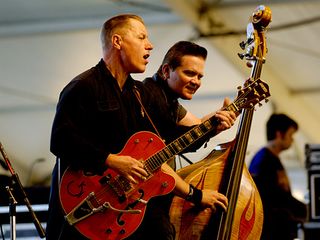
Reverend Horton Heat
Almost impossible to categorise, Jim Heath, otherwise known as The Reverend Horton Heat, leads a wild-ass trio from Dallas, Texas that serves up country, punk, big band, swing, lounge and rockabilly - and it’s all whoopin’ and stompin’, loud as all get-out and filled with humour. Hey, c’mon, the man has an album called Liquor In The Front (subtitled Poker In The Rear) - this ain’t Coldplay, folks.
Beneath his boisterous veneer, however, Heath is a dedicated student of the guitar who practices alternate picking over sweeping (he says it makes the notes “swing harder”). Check out this early video in which The Rev, White Falcon in hand, discusses his influences and schools everybody with a rippin’ rockabilly lesson that even includes a little Rock Around The Clock - not as easy as it seems.
Now known to millions of gamers worldwide with his song Psychobilly Freakout, which featured in Guitar Hero II, The Reverend occasionally plays a 1954 Gibson ES-175. Mainly, though, he sticks with Gretsch 6120Ws - and the company has now issued the 6120RHH (you can guess what the ‘HH’ stands for), which features the classic ‘G’ branding, a Bigsby B6CB vibrato tailpiece and TV Jones Classic pickups. Martinis not included.
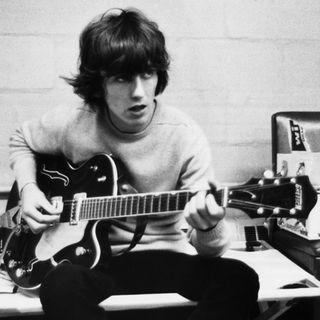
George Harrison
Harrison's impact on Gretsch sales following The Beatles' appearance on the Ed Sullivan Show in 1964 has already been documented in our entry on Chet Atkins. However, The Quiet One's relationship with Gretsch went further back than that.
Having saved £75 from gigs, in the summer of '61, George saw an advert for a Gretsch 6128 Duo Jet in the Liverpool Echo newspaper. The black 1957 model he purchased would be the guitar he favoured throughout the Hamburg and Cavern gigs that followed, and it went on to feature on countless recordings and travel around the world with The Beatles on tour.
The Tennessean pictured above - complete with fake painted f-holes - arrived during the Christmas tour of late 1963 and became a fixture throughout 1964 and 1965. Although his pioneering use of the Rickenbacker 12-string became part of '60s musical vernacular, the majority of George's six-string adventures in the pre-psychedelic Beatles were undertaken with a Gretsch in his hands.
Who have we missed? Let us know in the comments section below...
Liked this? Now read: 16 Rickenbacker guitar and bass stars
Connect with MusicRadar: via Twitter, Facebook and YouTube
Get MusicRadar straight to your inbox: Sign up for the free weekly newsletter

MusicRadar is the internet's most popular website for music-makers of all kinds, be they guitarists, drummers, keyboard players, DJs or producers.
GEAR: We help musicians find the best gear with top-ranking gear round-ups and high-quality, authoritative reviews by a wide team of highly experienced experts.
TIPS: We also provide tuition, from bite-sized tips to advanced work-outs and guidance from recognised musicians and stars.
STARS: We talk to artists and musicians about their creative processes, digging deep into the nuts and bolts of their gear and technique. We give fans an insight into the actual craft of music-making that no other music website can.

“The mini humbucker fits into the same sized pickup cavity as a P-90 and delivers low-noise humbucking pickup performance and a slightly brighter and more open tone”: Gibson remixes the Les Paul Special with mini humbuckers
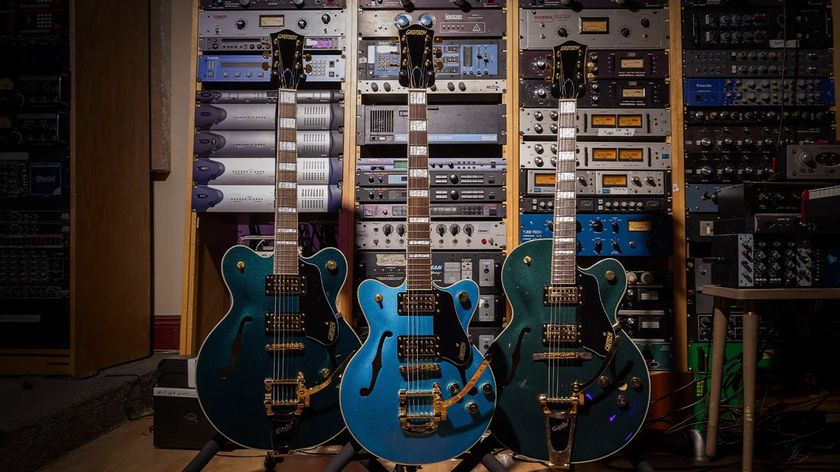
“Exceptional performance, sound, and style at an incredible value.”: Gretsch unveils trio of limited edition Streamliner electrics that offer Bigsby wobble, semi and hollow-bodied rock ’n’ roll mojo for $699

“The mini humbucker fits into the same sized pickup cavity as a P-90 and delivers low-noise humbucking pickup performance and a slightly brighter and more open tone”: Gibson remixes the Les Paul Special with mini humbuckers

“Exceptional performance, sound, and style at an incredible value.”: Gretsch unveils trio of limited edition Streamliner electrics that offer Bigsby wobble, semi and hollow-bodied rock ’n’ roll mojo for $699



![Chris Hayes [left] wears a purple checked shirt and plays his 1957 Stratocaster in the studio; Michael J. Fox tears it up onstage as Marty McFly in the 1985 blockbuster Back To The Future.](https://cdn.mos.cms.futurecdn.net/nWZUSbFAwA6EqQdruLmXXh-840-80.jpg)






